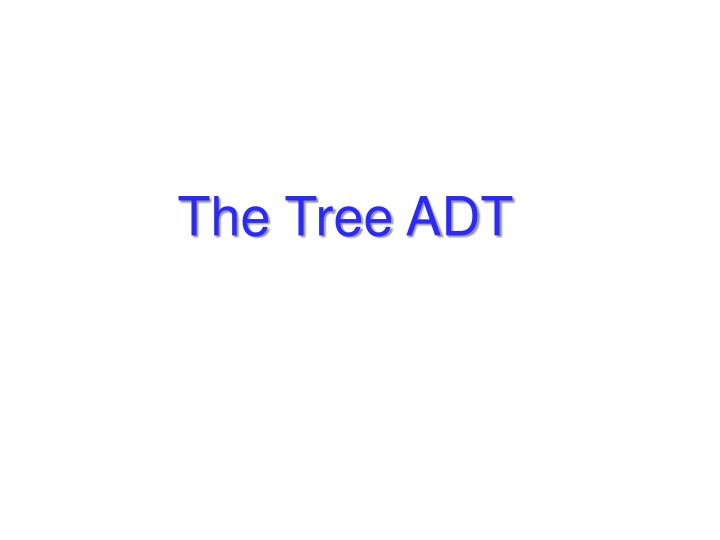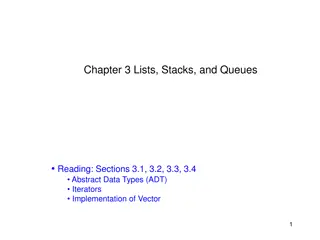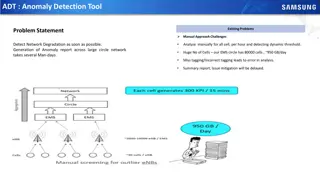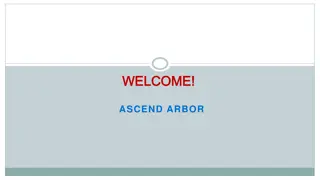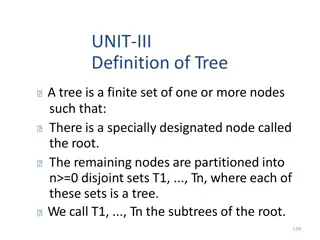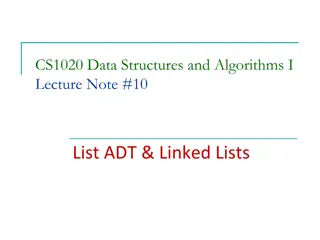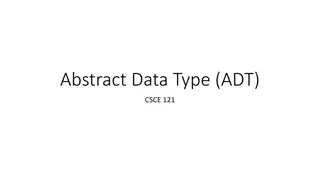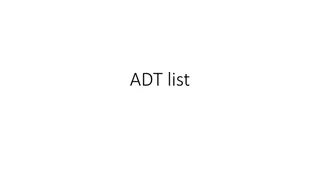The Tree ADT
Tree data structures are nonlinear abstract structures that store elements in a hierarchical manner. They are used in various real-life scenarios like family trees, book tables of contents, class inheritance hierarchies, and computer file systems. This content explores the definition of trees, traversal algorithms, binary tree implementations, and terminology associated with trees.
Download Presentation

Please find below an Image/Link to download the presentation.
The content on the website is provided AS IS for your information and personal use only. It may not be sold, licensed, or shared on other websites without obtaining consent from the author.If you encounter any issues during the download, it is possible that the publisher has removed the file from their server.
You are allowed to download the files provided on this website for personal or commercial use, subject to the condition that they are used lawfully. All files are the property of their respective owners.
The content on the website is provided AS IS for your information and personal use only. It may not be sold, licensed, or shared on other websites without obtaining consent from the author.
E N D
Presentation Transcript
Objectives Define trees as data structures Discuss tree traversal algorithms Discuss a binary tree implementation 10-2
Trees A tree is a nonlinear abstract data type that stores elements in a hierarchy. Examples in real life: Family tree Table of contents of a book Class inheritance hierarchy in Java Computer file system (folders and subfolders) Decision trees 10-3
Example: Computer File System Root directory of C drive Documents and Settings Program Files My Music Desktop Favorites Start Menu Adobe Microsoft Office 10-4
Example: Table of Contents Java Software Structures Introduction Analysis of Algorithms Index Software Quality Data Structures Algorithm Efficiency Big Oh Notatio Time Complexity 10-5
Example: Javas Class Hierarchy Object . . . Array Throwable String Rectangle Error . . . Exception . . . Square 3-6
Tree Definition A tree is a set of elements that either it is empty, or it has a distinguished element called the root and zero or more trees (called subtrees of the root) What kind of definition is this? What is the base case? What is the recursive part? 10-7
Tree Definition Root Subtrees of the root 10-8
Tree Terminology Nodes: the elements in the tree Edges: connections between nodes Root: the distinguished element that is the origin of the tree There is only one root node in a tree Empty tree has no nodes and no edges 10-9
Tree Terminology Root edge arc, or link node or vertex 10-10
Tree Terminology Parent or predecessor: the node directly above another node in the hierarchy A node can have only one parent Child or successor: a node directly below another node in the hierarchy Siblings: nodes that have the same parent Ancestors of a node: its parent, the parent of its parent, etc. Descendants of a node: its children, the children of its children, etc. 10-11
Tree Terminology Node A is the parent of nodes B, C, D, E A Nodes B, C, D, E are siblings Node E is a child of node A C B D E F G Nodes F, G and H are descendants of node B H Nodes F, B, and A are ancestors of node H All nodes, except A, are descendants of node A 10-12
Tree Terminology Leaf node: a node without children Internal node: a node with one of more children 10-13
Tree Terminology Interior or internal nodes Root Leaf nodes or external nodes 10-14
Discussion Does a leaf node have any children? Does the root node have a parent? How many parents does every node other than the root node have? 10-15
Height of a Tree A path is a sequence of edges leading from one node to another Length of a path: number of edges on the path Height of a (non-empty) tree : length of the longest path from the root to a leaf What is the height of a tree that has only a root node? 10-16
Tree Terminology Root A path A B C D E Path of length 3 F G H I J K L M N Height = 3 10-17
Level of a Node Level of a node: number of edges between root and the node It can be defined recursively: Level of root node is 0 Level of a node that is not the root node is level of its parent + 1 Question: What is the height of a tree in terms of levels? 10-18
Level of a Node Level 0 Level 1 Level 2 Level 3 10-19
Subtrees A subtree of a node consists of a child node and all its descendants A subtree is itself a tree A node may have many subtrees 10-20
Subtrees E Subtrees of the node labeled E 10-21
More Tree Terminology Degree of a node: the number of children it has Degree of a tree: the maximum of the degrees of the nodes of the tree 10-22
Degree Degrees of the nodes are indicated beside the nodes 4 A 0 3 0 2 B C D E 1 1 0 1 F G H I J 0 0 0 K L M 0 10-23
Binary Trees General tree: a tree each of whose nodes may have any number of children n-ary tree: a tree each of whose nodes may have no more than n children Binary tree: a tree each of whose nodes may have no more than 2children i.e. a binary tree is a tree with degree 2 The children of a node (if present) are called the left childand right child 10-24
Binary Trees Recursivedefinition of a binary tree: it is the empty tree, or a tree which has a root whose left and right subtrees are binary trees A binary tree is an ordered tree, i.e. it matters whether a child is a left or right child 10-25
Binary Tree A Left child of A Right child of A B C D E F G H I 10-26
Tree Traversals A traversal of a tree starts at the root and visits each node of the tree once. Common tree traversals: preorder inorder postorder level-order 10-27
Preorder Traversal Start at the root Visit each node, followed by its children; we will visit the left child before the right one Recursive algorithmforpreorder traversal: If tree is not empty, Visit root node of tree Perform preorder traversal of its left subtree Perform preorder traversal of its right subtree What is the base case? What is the recursive part? 10-28
Preorder Traversal public void preorder (BinaryTreeNode<T> r) { if (r != null) { visit(r); preorder (r.getLeftChild()); preorder (r.getRightChild()); } } 10-29
Preorder Traversal A B C D E F G H I In a preorder traversal of this tree the nodes are visited in the order ABDHECFIG 10-30
Inorder Traversal Start at the root Visit the left child of each node, then the node, then any remaining nodes Recursive algorithm for inorder traversal If tree is not empty, Perform inorder traversal of left subtree of root Visit root node of tree Perform inorder traversal of its right subtree 10-31
Inorder Traversal public void inorder (BinaryTreeNode<T> r) { if (r != null) { inorder (r.getLeftChild()); visit(r); inorder (r.getRightChild()); } } 10-32
Inorder Traversal A B C D E F G H I In an inorder traversal of this tree the nodes are visited in the order DHBEAIFCG 10-33
Postorder Traversal Start at the root Visit the children of each node, then the node Recursive algorithm for postorder traversal If tree is not empty, Perform postorder traversal of left subtree of root Perform postorder traversal of right subtree of root Visit root node of tree 10-34
Postorder Traversal public void postorder (BinaryTreeNode<T> r) { if (r != null) { postorder (r.getLeftChild()); postorder (r.getRightChild()); visit(r); } } 10-35
Postorder Traversal A B C D E F G H I In an postorder traversal of this tree the nodes are visited in the order HDEBIFGCA 10-36
Level Order Traversal Start at the root Visit the nodes at each level, from left to right Is there a recursive algorithm for a level order traversal? 10-37
Level Order Traversal A B C D E F G H I In a level order traversal of this tree the nodes will be visited in the order ABCDEFGHI 10-38
Level Order Traversal We need to use a queue: Start at the root Visit the nodes at each level, from left to right A B C D E F G queue H I 10-39
Level Order Traversal Put A in the queue A B C D E F G H I A 10-40
Level Order Traversal 1. Remove the first node from the queue A B C D E F G H I A 10-41
Level Order Traversal 2. Enqueue all neighbours of the node that was removed from the queue A B C D E F G H I B C A 10-42
Level Order Traversal Repeat steps 1 and 2 until the queue is empty A B C D E F G H I C A B 10-43
Level Order Traversal Repeat steps 1 and 2 until the queue is empty A B C D E F G H I C D E A B 10-44
Level Order Traversal Repeat steps 1 and 2 until the queue is empty A B C D E F G H I D E F G A B C 10-45
Level Order Traversal Repeat steps 1 and 2 until the queue is empty A B C D E F G H I E F G H A B C D 10-46
Level Order Traversal Repeat steps 1 and 2 until the queue is empty A B C D E F G H I F G H A B C D E 10-47
Level Order Traversal Repeat steps 1 and 2 until the queue is empty A B C D E F G H I G H I A B C D E F 10-48
Level Order Traversal Repeat steps 1 and 2 until the queue is empty A B C D E F G H I H I A B C D E F G 10-49
Level Order Traversal Repeat steps 1 and 2 until the queue is empty A B C D E F G H I I A B C D E F G H 10-50
